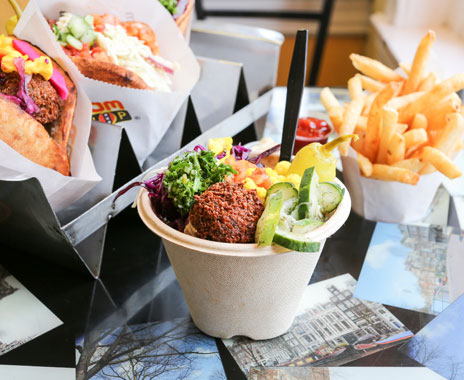Arianne Bennett never foresaw her restaurant offering delivery service, yet alone multiple delivery options. After all, her Amsterdam Falafelshop concept features piping hot falafel balls fresh out of the fryer. And customers are empowered to make whatever sandwich or salad concoction they desire by helping themselves to a bar of 22 toppings and sauces.
But now, some of her stores offer as many as four delivery choices as delivery has grown from an industry novelty to a mainstay.
“I think it’s going to become a big part of our business,” Bennett says. “It’s certainly not a model we ever considered when we first got started. Our expectation as a restaurant is we hand you a pita or a bowl and you fix it for yourself. We’ve never even had staff people making salads or sandwiches.”
Big names like Amazon, Uber, and Yelp are helping to spread delivery service across American cities. In late February, Amazon rolled out its Amazon Restaurants delivery service to many neighborhoods in the nation’s capital, expanding its earlier footprint from Northern Virginia.
“The hustle and bustle in the nation’s capital can make it difficult to try all the amazing restaurants around town,” says Gus Lopez, general manager of Amazon Restaurants, in a news release. “Now, Amazon Restaurants makes it easy to skip traffic and get delicious meals from top restaurants conveniently delivered to your office or home in an hour or less.”
The rollout gave Amazon Prime customers in Washington, D.C. access to more than 150 restaurants, including Amsterdam Falafelshop. Since launching the service in Seattle in 2015, Amazon Restaurants has grown to serve Prime customers in 20 cities across the country.
Bennett, a self-described perfectionist, acknowledges the occasional bout of anxiety from delivery, in which she gives up control over quality as soon as the driver leaves the store. But, she believes, customers are more forgiving with online delivery and don’t expect the same experience as they do in the store.
“I give up stuff when I order online,” she says. “Whether it’s getting 12 paper towel rolls instead of 18 or the shoe was a little tighter than I thought. You always know you’re taking that chance when you order online.”
She has experienced poor delivery service in the past—so poor that she dropped a previous provider—and she worries about how drivers interact with her customers at their doorsteps. After all, the third-party workers essentially become the face of her brand. But, she says, she’s been assured that Amazon is equally vigilant about maintaining high standards.
“Unlike some situations where a driver makes two more runs before taking the order, the reality is Amazon can’t afford to take that chance,” she says. “Amazon has to take it right to that customer because otherwise they’re messing not with just a food customer, but that could make their Prime customer angry.”
Delivery is no longer a service restaurateurs can afford to ignore, says Aaron Allen, CEO of global restaurant consulting firm Aaron Allen & Associates.
“There isn’t a restaurant on Planet Earth at this point that should not consider delivery,” he says. “That’s a big statement, we don’t usually speak in superlatives like that.”
Still, that doesn’t mean every brand needs to jump into delivery right away. It’s important to figure out how to do it correctly, ensuring operations can meet the unique challenges of preparing and packaging food for delivery. But brands that avoid partnering with the big delivery services risk not only not being discovered by new customers, but alienating existing ones who are already using Amazon, Yelp or Uber.
“What happens now when you discover new brands and you get hooked?” he says. “There’s such a fast migration and these brands usually don’t win it back.”
Allen expects an impending wave of consolidation among delivery service providers, eventually growing to resemble the way the market share of airlines, cell phone carriers, and hotel chains is concentrated among a few large players.
How big of a change should restaurateurs expect? Allen says it will be “so seismic and disruptive that I don’t think anybody, myself included, has actually accurately forecasted what that’s going to look like.” For the casual dining chains struggling the most, he expects delivery’s proliferation to sound the final death knell.
“For [quick service], it’s more significant and important than the drive-thru was,” Allen says.
Amsterdam Falafelshop had already incorporated Caviar, UberEATS, and Yelp EAT24 when it flipped the switch on Amazon’s delivery service in February at its Washington, D.C. store—a Dallas location will soon add the service, too. Incorporating another system was as easy as hanging a fourth tablet on the wall, Bennett says.
Four of the brand’s five stores currently offer delivery. While delivery has mushroomed in popularity, Bennett says, there’s still plenty of potential for growth.
“It’s probably 10 percent of our business,” she says. “But 10 percent of our business is nothing to sneeze at. It used to be a lot less … And I think people are getting more and more into ordering from their phones.”
Uber has driven more sales than Caviar or EAT24, primarily because the app already has a built-in customer base. Bennett expects the same to hold true for Amazon. While she’s faced slight pushback from team members that question the need for so many delivery services, Bennett says she sees no reason to turn down an opportunity for more business.
“As long as we can keep putting out the food, I’d be happy to add a tablet a month,” she says. “They all pay nicely.”








